Water snakes are nonvenomous, and they’ll only attack people if surprised or cornered. When it bites its saliva acts as an anticoagulant which causes excessive bleeding. It won’t just bite once; it will bite repeatedly, and the bite is very painful.
These ten types of water snakes are often confused with the more dangerous cottonmouth (water moccasin) and are killed unnecessarily out of fear.
What water snakes live in the United States? Let’s discover the 10 water snakes that call the United States home.
1. Brown Water Snake
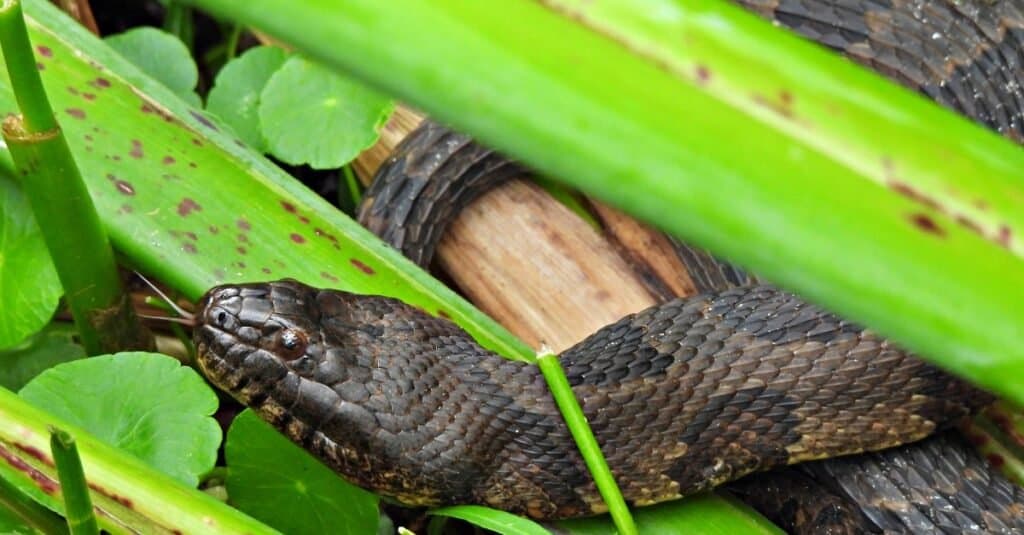
Brown water snakes sometimes fall into boats from the branches above the water.
©iStock.com/passion4nature
Brown water snakes live in the southeastern United States, particularly in areas around Georgia and South Carolina. These water snakes like to hang out in the branches above rivers and drop into the water when startled. This causes them to fall into unsuspecting boats, which is one of the ways that humans come face to face with the brown water snake.
They primarily eat fish, and they can grow to be 5 feet long. Because they lean toward a fish diet, they must be near a running and permanent water source so they can access their prey. They like to spend their time near streams and creeks. They have a narrower head than other water snakes on this list.
2. Northern Water Snake

Most northern water snakes are brown and tan though some are also grey and red.
©jmarino/Shutterstock.com
Northern water snakes are known as common water snakes and are found in the eastern and central United States but are most abundant in the northeastern United States. They like to take over muskrat and beaver dens to use as burrows.
These snakes can grow up to 5 feet in length and they also hibernate during the winter. These snakes are mostly brown and tan with some leaning toward red or gray hues. Around its neck are dark crossbands. Blotches that are almost crossbanded themselves appear along the body of the northern water snake.
There are subspecies of this snake including the midland, Carolina, and Lake Erie water snake.
Lake Erie water snakes live on islands on the west side of Lake Erie and are a subspecies of the northern water snake. This snake had a rapidly declining population until the round goby was introduced. Round gobies are invasive, so it was a problem that they showed up. The Lake Erie water snake made the round goby 90% of its prey, and their numbers increased.
3. Green Water Snake

The green water snake spends more time in the sun than other water snakes.
©Ryan M. Bolton/Shutterstock.com
This water snake, when compared to the others on this list, spends more time basking in the sun than average. These snakes tend to like steep and bare shorelines. They grow up to 4.5 feet in length.
The green water snake is found in the southeastern United States, particularly in Mississippi.
4. Concho Water Snake
This snake lives in the river systems of the Colorado and Concho of Texas. They grow to be about 2.5 feet in length, and they have blotches down their bodies in rows. Because of its narrow range in Texas, this snake is considered to have the smallest distribution area of any other American snake.
These snakes like water from streams going over rocks, and their diet is almost all fish. While they will go looking for prey occasionally, they like to hang out near schools of fish waiting for the right opportunity to pounce.
5. Diamondback Water Snake
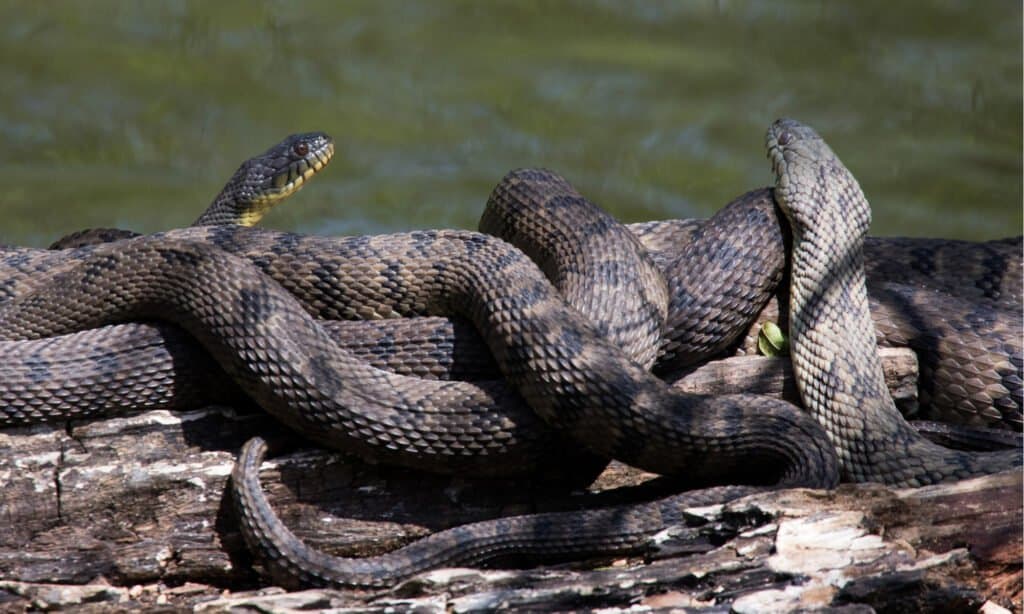
Diamondback water snakes like bare shorelines.
©Laurie L. Snidow/Shutterstock.com
These snakes tend to like steep and bare shorelines. Abstractly, the markings on their back are kind of like diamonds, which is where the snake got its name. These snakes have a protuberance on their chin, and it’s the only snake in the United States with one.
The Diamondback water snake likes to lay in the branches above water sources. They dip their heads from these branches beneath the water searching for their meal. This water snake is found in the Mississippi River valley as well as in a variety of central and southern states.
6. Yellow-Bellied Water Snake
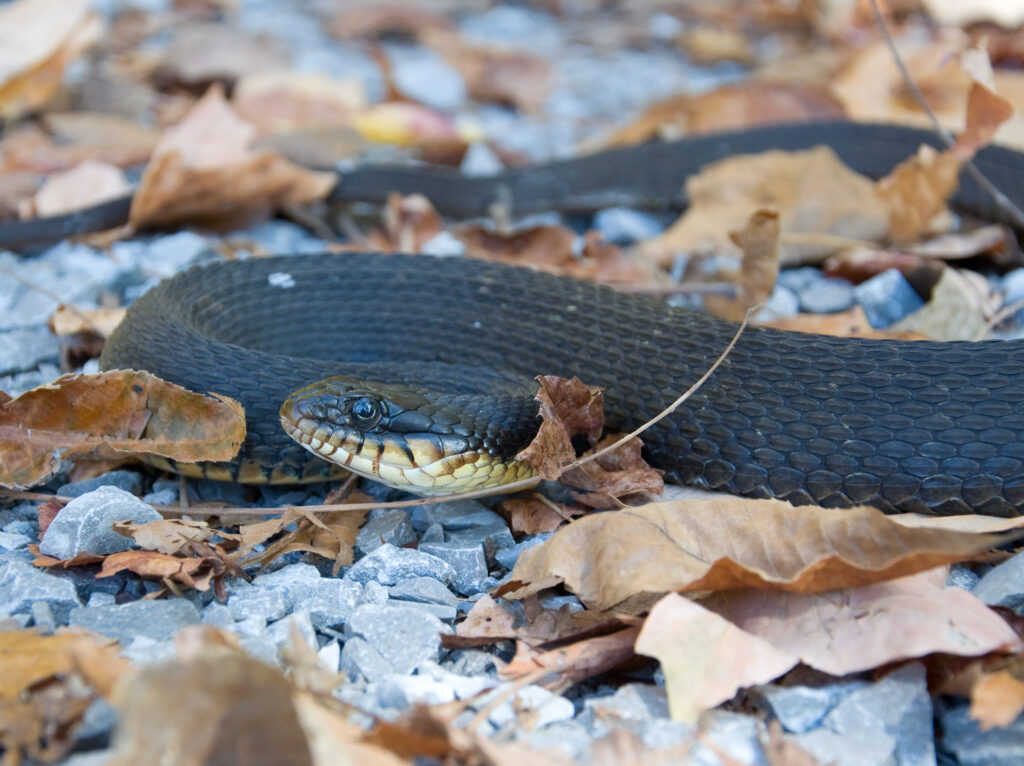
Yellow bellied water snake, Nerodia erythrogaster flavigaster, amidst some fallen leaves in the Shawnee National Forest.
©Gerald A. DeBoer/Shutterstock.com
The plain-belly water snake, more commonly known as the yellow-bellied water snake, grows up to 4 feet in length. These snakes do indeed have a yellow belly as their name suggests.
While these snakes love the water like any other water snake, they prefer to stay away from rushing water. These snakes tend to like steep and bare shorelines. The yellow-bellied water snake will venture farther away from water than others on this list.
These snakes are not patterned and can be found in black, olive, gray, and brown. They wait to ambush their prey instead of hunting them down while most other water snakes actively chase their prey.
7. Banded Water Snake
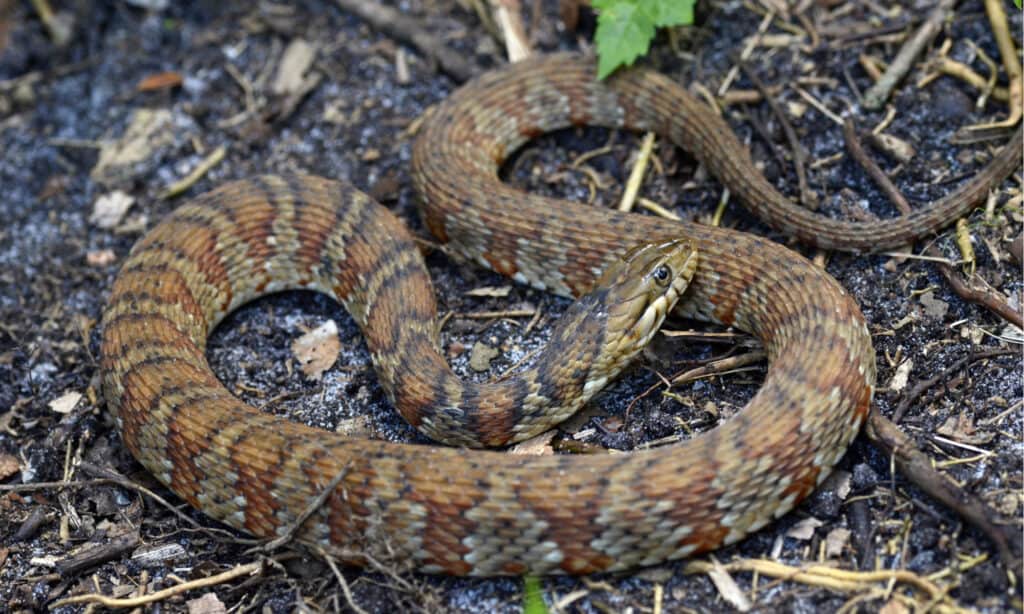
Banded water snakes like to lay out in the open at night.
©Patrick K. Campbell/Shutterstock.com
Banded water snakes live from Alabama to North Carolina in the United States. They also live in Arizona, Georgia, Texas, and Florida. Banded water snakes are also well known as southern water snakes since they reside in southern regions of the United States.
Compared to other water snakes, banded water snakes tend to lay out in the open at night. They can be found both in barren areas and those with vegetation.
8. Florida Green Water Snake
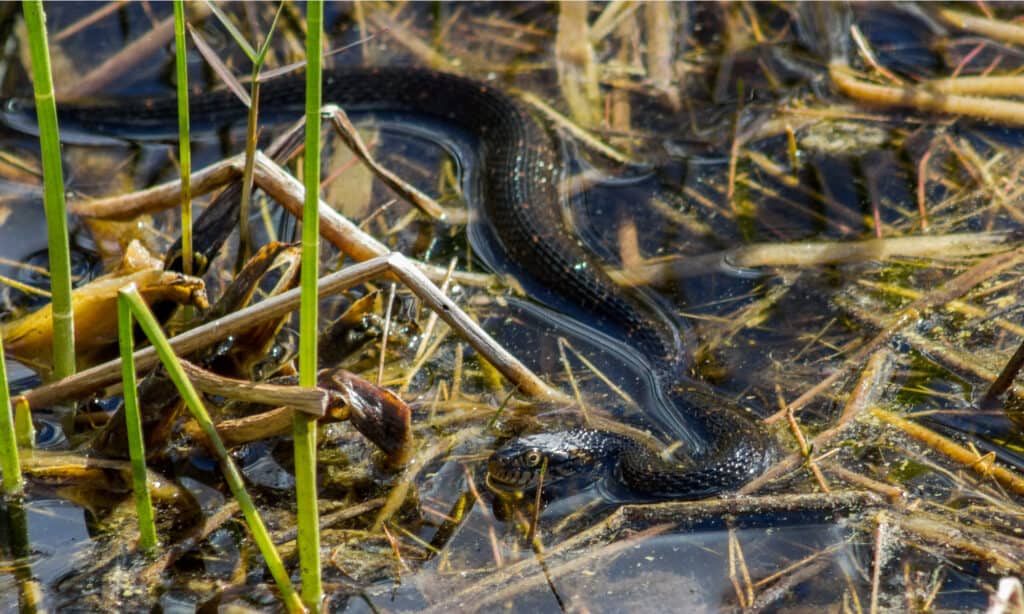
Florida green water snakes like areas with vegetation in the water.
©EdwinWilke/Shutterstock.com
As their name suggests, these snakes are most often green but they can be found in oranges and browns as well. They have a speckled pattern to them, but nothing too pronounced. These snakes have a smaller range in just Florida; they’re not in the whole state.
Florida green water snakes can grow to be 4.5 feet long. These snakes really like areas where vegetation grows out of the surface of the water. They eat mainly fish and amphibians.
9. Saltmarsh Water Snake
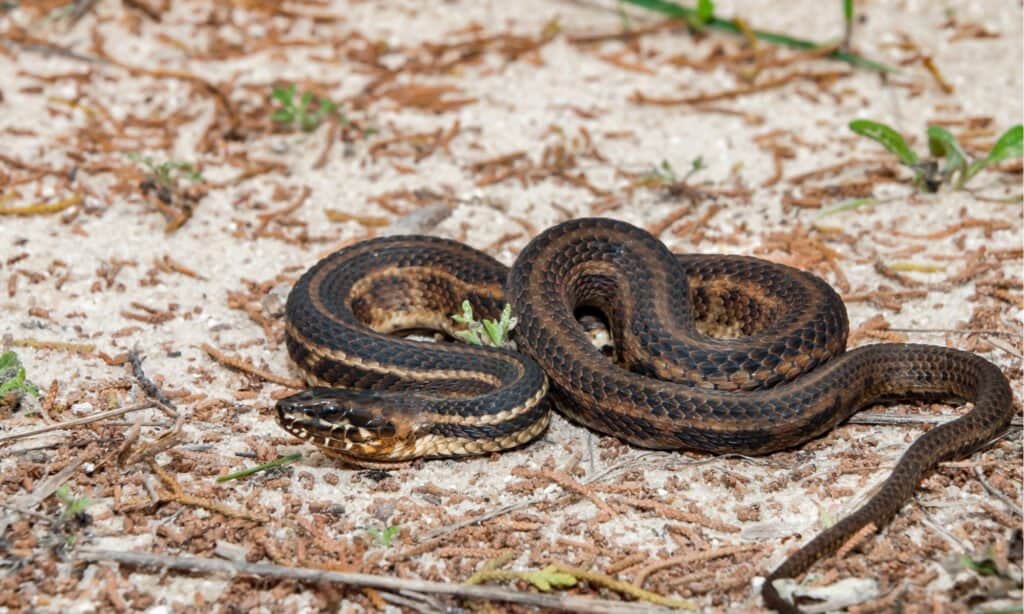
Saltmarsh water snakes prefer saltwater habitats.
©Jay Ondreicka/Shutterstock.com
Saltmarsh water snakes have an average length of 3 feet. Three subspecies of this snake exist. They have stripes down the length of their body but some don’t have stripes at all.
They live in the southeastern United States and prefer calm saltwater habitats like mudflats, estuaries, and salt marshes. They like to eat crabs, fish, and shrimp that get trapped on land by the tide. They’re usually out at night to avoid birds of prey.
Check out the largest salt marsh snake ever recorded.
10. Brazos Water Snake
The Brazos water snake is often called the Harter’s water snake. This snake lives in the Brazos River system in Texas. These snakes seek shelter in rocks along the river. This snake can be as long as 2.5 feet.
10 Types Of Water Snakes That Live In The United States
The 10 types of water snakes that live in the United States are:
- Brown Water Snakes
- Northern Water Snakes
- Green Water Snake
- Concho Water Snake
- Diamondback Water Snake
- Yellow-Bellied Water Snakes
- Banded Water Snakes
- Florida Water Snake
- Salt Marsh Water Snake
- Brazos Water Snake
Water Snake Facts
All the 10 water snakes that live in the United States have round pupils. This is one of the defining characteristics when comparing it to a cottonmouth.
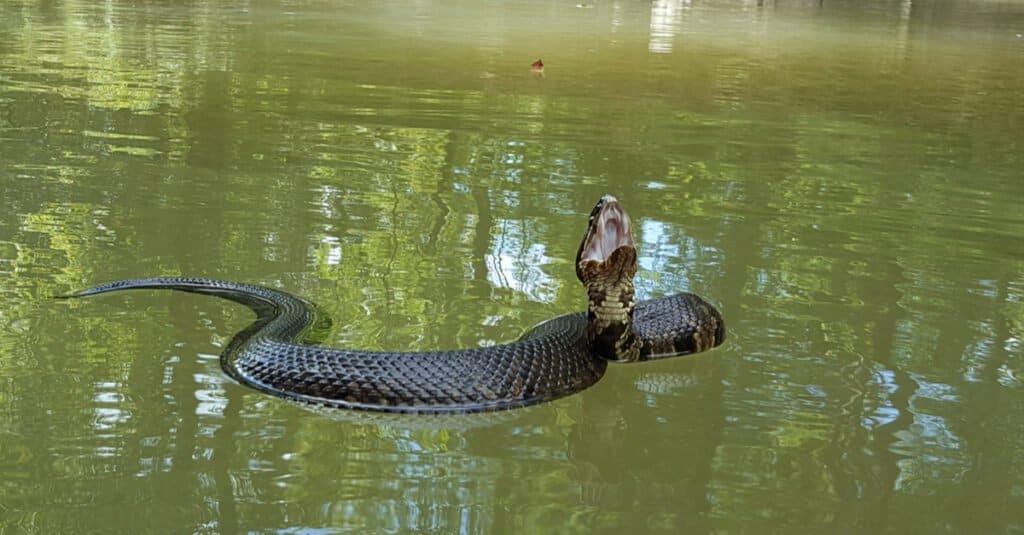
Cottonmouth snakes are venomous and have longer, thicker, bodies than other water snakes.
©Seth LaGrange/Shutterstock.com
All the water snakes in the United States tend to prefer the same habitats, such as swamps, marshes, ponds, wetlands, streams, and lakes. They like to lounge in branches above water sources or sun themselves on rocks or in open spaces. They dine on toads, fish, frogs, and other small animals found around the water.
Water snakes are so well adapted to their aquatic environment that they can hold their breath for up to 2 hours. As babies, they start eating insects and move to larger prey as they get bigger.
When water snakes feel threatened, they flatten themselves. They often emit a foul-smelling musk from their anal glands before trying to bite repeatedly.
Other Water Snakes Found Found In The U.S.

Water moccasins are also called cottonmouths because the inside of their mouths is white.
©Rini Kools/Shutterstock.com
The cottonmouth is found in the southeastern United States and is one of the world’s few semi-aquatic pit vipers. These large snakes, also known as water moccasins, are capable of delivering a painful and potentially fatal bite. While not aggressive, people often stumble upon these venomous snakes while walking through wooded areas thick with fallen pine straw and leaves or while swimming or fishing in lakes and slow-moving rivers.
Many harmless water snakes have been killed unnecessarily after being mistaken for the dangerous water moccasin. While many of the harmless water snakes share the coloration of the cottonmouth – if you take a second look – it is easy to tell them apart. Here are some ways to identify the venomous water moccasin:
- Body shape – The water moccasin is much thicker and heavier than other water snakes.
- Head shape – Non-venomous water snakes tend to have slender or flattened heads while a cottonmouth’s head is thick and blocky.
- Neck – The water moccasin has a narrow neck that is obviously smaller than its head, while other water snakes do not have distinct necks.
- Eyes – Cottonmouths have vertical pupils – other water snakes’ pupils are round.
- Face – Water moccasins have heat-sensing pits on their faces while other water snakes do not.
The photo featured at the top of this post is © Michiel de Wit/Shutterstock.com
Discover the "Monster" Snake 5X Bigger than an Anaconda
Every day A-Z Animals sends out some of the most incredible facts in the world from our free newsletter. Want to discover the 10 most beautiful snakes in the world, a "snake island" where you're never more than 3 feet from danger, or a "monster" snake 5X larger than an anaconda? Then sign up right now and you'll start receiving our daily newsletter absolutely free.
Thank you for reading! Have some feedback for us? Contact the AZ Animals editorial team.






